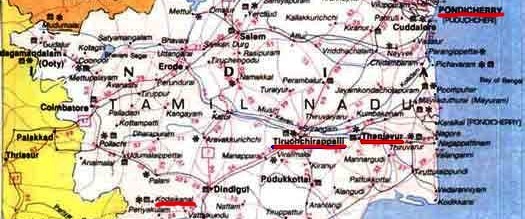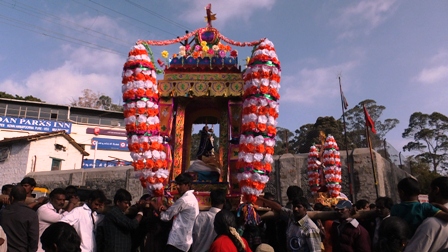Southern India Revisited
Episode 4: Kodaikanal (Kodai) Hillstation

Click the photo above to see an album of photos
Previous: Episode 3: Trichy and Tanjore Next: Episode 5: Shared Taxi to Munnar|
9-11 February 2013 Into the Hills of Kodaikanal (Kodai)
We had seen enough Tamil Nadu temples and we were ready for the hills of the Western Ghats with their cooler temperatures and opportunity for some nice day walks. Kodaikanal, at 2100m elevation, was a hill station for British colonizers who wanted to escape the heat of the lowlands. We got there on a direct bus from Trichy. It took almost 5 hours, the last 50 km of which was a scenic ride completely uphill. We had a seat all the way and the driver, thankfully, took the many curves on the hills slowly and cautiously. Kodai spills down over all sides of the hills just above a small lake. We stayed in one of the better hotels close to the center with many good restaurants and small shops. Kodai remains popular as a vacation spot for Indians and Westerners; although there were more Indian tourists there for the weekend we visited than tourists from other countries. As Canadians, we seem to be in the minority. Our first full day after arriving in a town, especially after a long bus ride, is for catching up on the internet, relaxing, getting to know our surroundings and making arrangement for our next stop. We did all of that. To be able to spend more time in the hills we booked a flight from Cochin airport to Goa on February 16, the day we take possession of our condo on Benaulim Beach. We walked down to the lake, which would look prettier if it was not weed clogged at the edges. There were pedal boats and bicycles to rent. There is a 5 km route around the lake that would be all I would want to do on a bike. The rest of the area is nothing but hills. We walked back to town past several stone houses and churches, a legacy from the British. We found the short Coaker’s Walk for which we paid Rs20 to walk with a camera and enjoy the view of the surrounding mountains and mist filled valleys. Later in the afternoon we were back in our room when I heard a band playing and looked out the window to see what looked like a parade heading down the main street towards us. We both rushed out with our cameras to find it was a Christian religious parade. Men were carrying two large floats supported by long bamboo poles over their shoulders. One float had a doll figure brandishing a sword over a dragon-like figure representing St Michael, the archangel. The other was St Anthony in priest’s apparel. In Ottawa, St Anthony is the patron saint of the Italian community. There were crowds of locals watching the procession, halting traffic at an intersection and stopping to bang drums and play trumpets. The locals, many of whom had Hindu puja dots, bowed their heads in prayer to the saints, lifted their children up to see the saints and took handful of rice from the float platforms, much as they do at a morning Hindu or Buddhist service. It was definitely a composite of Christianity and Hinduism. We were told later than Kodai is an anomaly in Tamil Nadu, being very tolerant and inclusive of other religions. At breakfast the next day an older Indian man introduced himself to us and asked if we had visited the famed Kodaikanal International School, just across from the hotel. Ray told him he had tried to take a photo from the road and was told that photos were not allowed and the school was closed to casual visitors. The man, who was in town for a director’s meeting of the school, said he could arrange a tour for us. He took Ray to the school gate and arranged with the gate keeper to let us in later in the afternoon. We were to ask for Anita, the school secretary and all would be arranged. In the meantime we had arranged a half day guided hike in the area. Our guide, Serkam, met us at our hotel with two young East Germans, Anna, a teacher, and Flo (Florian), a landcape architect. We started out on a path on the edge of a mountain through Eucalytus trees to some small, pretty waterfalls. Following the stream farther up we came to another set of waterfalls that were near the road. Other tourists, who are not big walkers, drive to this point to see the waterfalls. We walked on the main road about 10-15 minutes, entertained on the way by troop of Grey Langurs. At the end of the road was a small village with a guesthouse sporting a large sign in Hebrew and a picture of a Rabbi. It was a gathering place for young Israelis, most probably travelling after compulsory military duties. There was a dirt road continuing from the end of the paving that took us to our tea break restaurant and enjoy the view. Our destination was about 1 km down a steep, rocky path to Dolphin Nose rock, a favourite place for Indian couples to go and have their picture taken. We were no different. We admired the view from several spots and Anna and Flo posed for us on the narrow outcrop. We retraced our route back to the waterfalls and from there it was an easy walk about 2 km along the road to La Salette Church, a pleasant small refuge started by one of the earlier colonizers. We said goodbye to our guide and walking companions at Greenlands Youth Hostal, where we had booked our hike. It had been a very pleasant half day. Back in town we just had time to grab some samosas and pakoras for lunch before our 3 PM appointment at the Internationally renowned Kodaikanal International School. We were directed to the Registration office where a young man, who turned out to be a 2006 graduate of the school from Tibet, called our contact, Anita, directed us to the Admin office. Jill, from NZ, was to be our guide. She and her husband Andrew, the Principal of the school, from Australia, had been at the school for 3 years. Jill gave us a great, very informative tour. We were in the High School area, apart from the Junior School which accommodates 3-12 year old in small cottages. Jill said there was one very young student whose parents were both airline pilots in India and were away much of the time and Jill considered the child was better cared for at the school than left with a nanny. There are between 500-600 students in all from 38 countries. Lonely Planet said the staff numbered 300 and were also from as many countries. The school was founded in 1901 by an American woman for children of missionaries. There is a big beautiful stone church on the property and religion is still part of the curriculum, but Jill emphasized that understanding and study of world religions was the emphasis. The school requires the students to study at least one other language, usually taught by a native speaker of that language. There is also an intensive music program, including a band, an orchestra, a burgeoning choir and 38 pianos to use. We were shown a row of small practise rooms and met with the music teacher, a very enthusiastic American man who is in his third year at the school along with his wife and two children. The choir spent the month of December in Germany where they attended two operas, a concert and participated in several practices and performances with other choirs. It was a great success. Everywhere we went Jill introduced us to students, who told us where they were from and how long they had been at the school. Most of the high school students were there for the International Baccalaureate, and were finishing or starting three years. Jill explained there is a rigorous interview process to select students who were college bound, were self motivated and well rounded. We visited the well stocked library and saw several classrooms. The school has an outdoor activity program and sports and requires each student to undertake a volunteer assignment. It was all most impressive. Jill said the school sometimes makes the students and teachers think they are at the model for Hogwarts and they feel like Harry Potter compatriots. We were given a few brochures that listed tuition cost at approx $20,000 per 5 month term. Terms are January to May and July to November with December and June holiday months. We ended our tour in the staff lounge where the teachers were having tea and a cake or snack. We got to meet and talk to several teachers, including a student from Montana who had come with two other girls on an exchange for their last term for their Education degree. Ray spoke to a girl from Korea who teaches the 40 Korean students. We heard nothing but glowing reports from everyone we met at the school. This would be a great experience for any child to be in a different part of the world and to receive a well rounded education at the same time. |
Previous: Episode 3: Trichy and Tanjore Next: Episode 5: Shared Taxi to Munnar
Read Sri Lanka 2013
Return to India 2013 Intro
Return to India Chronicles 2000-2001
Return to Travels
or Introduction
